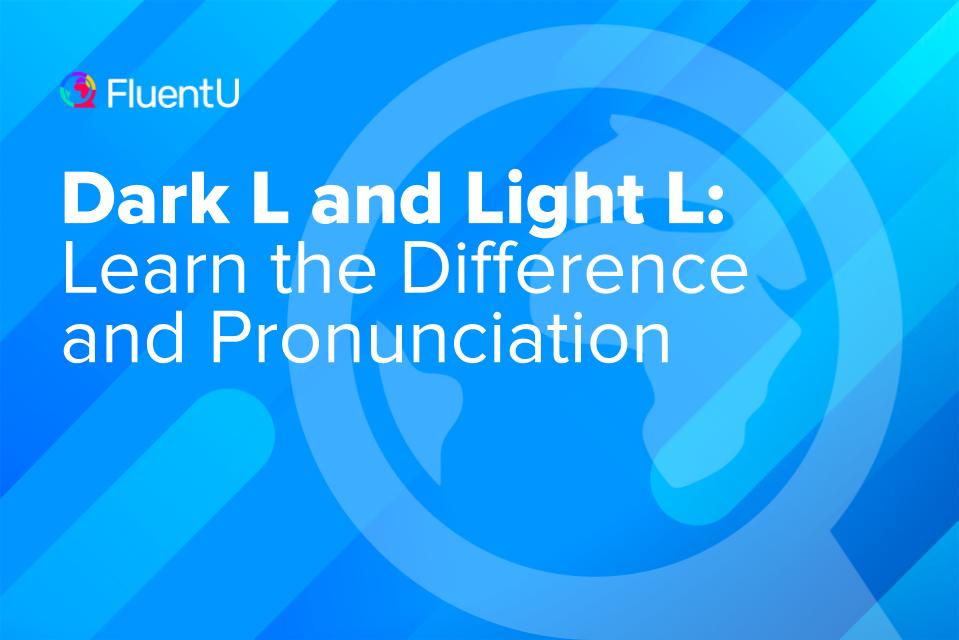Dark L and Light L: Learn the Difference and Pronunciation

It’s not obvious, but there are actually two kinds of L in English: the dark L and the light L.
L at the beginning of a word or syllable (or before a vowel) is the light L, such as in laugh .
L at the end of a word or syllable (or after a vowel) is the dark L, such as in pillow .
This post will explain how to pronounce these two variations of the L sound, with plenty of examples and audio you can use to practice your pronunciation.
Download: This blog post is available as a convenient and portable PDF that you can take anywhere. Click here to get a copy. (Download)
Light L Pronunciation
When to use it: At the start of a word or syllable—before a vowel or the letter Y
How to pronounce it:
- Put the tip of your tongue on the bony ridge behind your front teeth.
- Make a sound as you push with your tongue. If you hold this, you’re already saying the L sound as Lllllll!
- Lift your tongue off the ridge as you move on to the next vowel.
When you’re pronouncing the light L in everyday conversations, it’ll feel like a quick tap with your tongue. Remember to exert enough pressure, though, when you make the tap! A common mistake is tapping too lightly—the L sound has to be clearly heard.
Examples:
The light L also appears in the middle of a word as long as it’s before a vowel.
Try it out:
Larry left behind a long letter for his friend.
After my language class last evening, I was less nervous about speaking in English.
Dark L Pronunciation
When to use it: At the end of a word or syllable—after a vowel or the letter Y
How to pronounce it:
- Since it can be tricky to pronounce the dark L on its own, start by saying the vowel, first. With the word “ball,” the vowel would be A.
- For the actual dark L sound, move your tongue so the tip is reaching up and close to the bony ridge behind the front teeth but not touching.
- At the same time, the back of your tongue would be arching up a little towards your soft palate.
Examples:
The easiest to spot placement of the dark L is at the end of words:
You’ll also spot it in the middle of words as long as it’s after a vowel:
If you see L after a TT or DD, that’s a dark L too! For example:
This is because as you transition from the T or D to L, you have to make a quick uh sound, which counts as a vowel.
Try it out:
I’d rather send an email to the school instead of trying to call.
They’re having a pool party this fall to welcome new members.
Tips for Pronouncing Dark L and Light L
Ready to put what you’ve learned about the dark L and the light L into practice? Here’s how you can practice this pronunciation difference:
1. Pay attention to your tongue
It feels kind of strange to notice what your tongue is doing, but it really helps with this because the light L and dark L have differences in their mouth positioning.
- The light L’s mouth positioning is pretty simple—just point your tongue to the bony ridge above your teeth.
- For the dark L, you can imagine your tongue as forming a U shape that’s a bit flat and it’s further back in your mouth.
2. Think of the dark L as being made up of two sounds
The dark L is made up of two sounds: uh followed by L. If you say the dark L in slow motion, the uh is produced as you raise the back of your tongue, then the L follows when you raise the tip.
3. Test out your dark L vs. light L skills by reading out loud
Once you feel like you’ve gotten a grasp of how to pronounce the light L and dark L separately, you can level up to reading full-on words and sentences.
Grab an English book or article (this blog post works, too!) and choose a paragraph. Then, start hunting for words with the letter L.
For each word, ask yourself: is the L here a light L or a dark L?
Remember the main rules for L sounds:
- If the L is before a vowel, then it’s a light L.
- If the L is after a vowel, that’s a dark L.
4. Take advantage of videos and podcasts
It’s usually easier to think about your pronunciation when you’re reading because you can slow down. But here’s another challenge: bump it up by imitating native speakers in videos and podcasts, like FluentU.
FluentU takes authentic videos—like music videos, movie trailers, news and inspiring talks—and turns them into personalized language learning lessons.
You can try FluentU for free for 2 weeks. Check out the website or download the iOS app or Android app.
P.S. Click here to take advantage of our current sale! (Expires at the end of this month.)

5. Play around with L-sound tongue twisters
Tongue twisters are phrases or sentences that even native speakers struggle to pronounce, especially when they have to say the words faster and faster! These usually have similar-sounding words. For example, one popular tongue twister has the words “batter,” “bitter,” “butter” and “better” almost next to each other.
There are plenty of tongue twisters out there that feature the L sound, so you can have a bit of fun with them. Here’s one from Dr. Seuss’ “Fox in Socks” that goes all in with that light L:
Duck takes licks in lakes Luke Luck likes.
Luke Luck takes licks in lakes duck likes.
This dark L tongue twister is shorter, but it’s still a challenge to say:
Pale of ail aiding Al’s travails as frail sails flail.
For a mix of light L and dark L words, check out these two tongue twisters:
I slit the silk, the silk I slit, and on the slitted silk I fall lightly.
Seventeen sales slips slithered slowly southwards.
Now that you’ve learned all about the differences between the light L and the dark L, you won’t see the L sound in English the same way again.
You’ll spot 548 Ls in this post, so practicing both types of L will definitely come in handy—maybe as soon as your next English sentence!
And One More Thing...
If you like learning English through movies and online media, you should also check out FluentU. FluentU lets you learn English from popular talk shows, catchy music videos and funny commercials, as you can see here:
The FluentU app and website makes it really easy to watch English videos. There are captions that are interactive. That means you can tap on any word to see an image, definition, and useful examples.
For example, when you tap on the word "searching," you see this:
Learn all the vocabulary in any video with quizzes. Swipe left or right to see more examples for the word you’re learning.

FluentU helps you learn fast with useful questions and multiple examples. Learn more.
The best part? FluentU remembers the vocabulary that you’re learning. It gives you extra practice with difficult words—and reminds you when it’s time to review what you’ve learned. You have a truly personalized experience.
Start using the FluentU website on your computer or tablet or, better yet, download the FluentU app from the iTunes or Google Play store. Click here to take advantage of our current sale! (Expires at the end of this month.)










